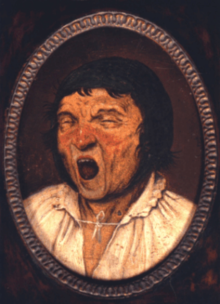This article needs additional citations for verification. (February 2020) |
| Meige's syndrome | |
|---|---|
 | |
| This 16th-century painting by Flemish artist Pieter Bruegel the Elder is one of the oldest known depictions of the facial dystonia associated with this syndrome. | |
| Specialty | Neurology |
Meige's syndrome is a type of dystonia. It is also known as Brueghel's syndrome and oral facial dystonia. It is actually a combination of two forms of dystonia, blepharospasm and oromandibular dystonia (OMD).
When OMD is combined with blepharospasm, it may be referred to as Meige's Syndrome named after Henri Meige,[1] the French neurologist who first described the symptoms in detail in 1910. The symptoms usually begin between the ages of 30 and 70 years old and appear to be more common in women than in men (2:1 ratio). The combination of upper and lower dystonia is sometimes called cranial-cervical dystonia.[2] The incidence is about one case in 20,000 people.[3]
- ^ synd/547 at Who Named It?
- ^ Ananth J, Edelmuth E, Dargan B (April 1988). "Meige's Syndrome Associated with Neuroleptic Treatment". American Journal of Psychiatry. 145 (4): 513–515. doi:10.1176/ajp.145.4.513. PMID 2894781.
- ^ Boodman, Sandra G. (April 23, 2012). "Medical mysteries: I opened my laptop and my eyes snapped shut". Washington Post. Retrieved April 24, 2012.